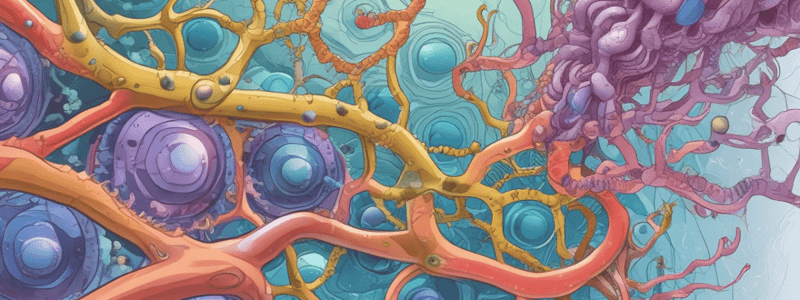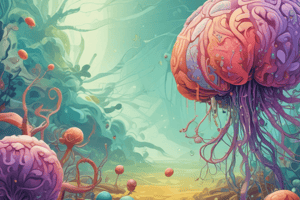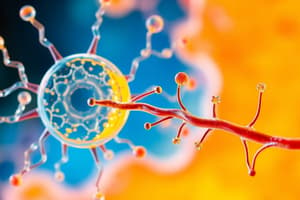Podcast
Questions and Answers
What is the study of microorganisms?
What is the study of microorganisms?
- Botany
- Zoology
- Ecology
- Microbiology (correct)
What is the function of the nucleus in a cell?
What is the function of the nucleus in a cell?
- Waste removal
- Contains genetic material (DNA) (correct)
- Protein synthesis
- Energy production
What is the process by which cells generate energy in the absence of oxygen?
What is the process by which cells generate energy in the absence of oxygen?
- Mitosis
- Respiration
- Fermentation (correct)
- Photosynthesis
What is the study of the interactions between organisms and their environment?
What is the study of the interactions between organisms and their environment?
What is the function of mitochondria in a cell?
What is the function of mitochondria in a cell?
What is the term for the thread-like structures that carry genes?
What is the term for the thread-like structures that carry genes?
What is the process by which plants convert sunlight into energy?
What is the process by which plants convert sunlight into energy?
What is the type of cell that has a nucleus?
What is the type of cell that has a nucleus?
Flashcards are hidden until you start studying
Study Notes
Branches of Biology
- Botany: study of plants
- Zoology: study of animals
- Microbiology: study of microorganisms
- Ecology: study of interactions between organisms and their environment
Cell Biology
- Cell: basic unit of life
- Prokaryotic cells (no nucleus): bacteria
- Eukaryotic cells (with nucleus): plants, animals, fungi, protists
- Cell membrane: semi-permeable membrane that separates cell from environment
- Cell organelles:
- Nucleus: contains genetic material (DNA)
- Mitochondria: generates energy for cell
- Ribosomes: site of protein synthesis
- Endoplasmic reticulum: involved in protein synthesis and transport
- Lysosomes: contains digestive enzymes
Genetics
- DNA (Deoxyribonucleic acid): genetic material that carries information
- Genes: segments of DNA that code for specific traits
- Chromosomes: thread-like structures that carry genes
- Inheritance:
- Dominant and recessive traits
- Mendel's laws of inheritance
Evolution
- Charles Darwin's theory of evolution by natural selection
- Mechanisms of evolution:
- Mutation
- Genetic drift
- Gene flow
- Natural selection
- Evidence for evolution:
- Fossil record
- Comparative anatomy
- Molecular biology
Ecology
- Ecosystem: community of organisms and their environment
- Energy flow:
- Producers (plants): convert sunlight into energy
- Consumers (animals): obtain energy by consuming other organisms
- Nutrient cycles:
- Carbon cycle
- Nitrogen cycle
- Water cycle
Biological Molecules
- Carbohydrates: energy source for cells
- Proteins: structural and functional molecules
- Lipids: energy storage and structure
- Nucleic acids: DNA and RNA
Biological Processes
- Photosynthesis: process by which plants convert sunlight into energy
- Respiration: process by which cells generate energy
- Fermentation: process by which cells generate energy in absence of oxygen
Branches of Biology
- Botany focuses on the study of plants, including their structure, growth, reproduction, and metabolism.
- Zoology involves the study of animals, exploring their behavior, physiology, and taxonomy.
- Microbiology investigates microorganisms, covering bacteria, viruses, fungi, and protozoa.
- Ecology examines the interactions between organisms and their environments, emphasizing ecosystems and biodiversity.
Cell Biology
- A cell is the fundamental unit of life, classified into two types:
- Prokaryotic cells lack a nucleus and include bacteria.
- Eukaryotic cells contain a nucleus and are found in plants, animals, fungi, and protists.
- The cell membrane is a semi-permeable barrier that regulates entry and exit of substances.
- Cell organelles perform specific functions:
- The nucleus stores genetic material (DNA).
- Mitochondria generate energy via cellular respiration.
- Ribosomes are the sites of protein synthesis.
- The endoplasmic reticulum is involved in protein synthesis and transport.
- Lysosomes contain digestive enzymes for breaking down waste materials.
Genetics
- DNA (Deoxyribonucleic acid) is the hereditary material responsible for storing and transmitting genetic information.
- Genes are segments of DNA that code for specific traits.
- Chromosomes are structures that organize DNA within the nucleus, consisting of genes.
- Inheritance principles include:
- Dominant traits overshadow recessive traits in phenotype expression.
- Mendel's laws of inheritance describe how traits are passed from parents to offspring.
Evolution
- Charles Darwin proposed the theory of evolution by natural selection, explaining how species adapt and evolve over time.
- Evolution mechanisms include:
- Mutation introduces genetic variation.
- Genetic drift leads to changes in allele frequencies within a population.
- Gene flow is the transfer of genetic material between populations.
- Natural selection favors advantageous traits for survival and reproduction.
- Evidence supporting evolution comes from:
- The fossil record, which shows historical life forms.
- Comparative anatomy, revealing similarities among species.
- Molecular biology, which analyzes genetic material across different organisms.
Ecology
- An ecosystem comprises a community of organisms and their physical environment.
- Energy flow within ecosystems involves:
- Producers (plants) converting sunlight into energy through photosynthesis.
- Consumers (animals) obtaining energy by feeding on other organisms.
- Nutrient cycles are essential for ecosystem sustainability:
- The carbon cycle regulates carbon's movement through the environment.
- The nitrogen cycle describes the conversion of nitrogen in various forms within ecosystems.
- The water cycle outlines the movement of water through evaporation, condensation, and precipitation.
Biological Molecules
- Carbohydrates serve as primary energy sources and structural components in cells.
- Proteins fulfill various functions, including catalyzing reactions and providing structure.
- Lipids are important for energy storage and cellular structure as part of membrane composition.
- Nucleic acids, namely DNA and RNA, are crucial for genetic information storage and transmission.
Biological Processes
- Photosynthesis enables plants to convert sunlight into chemical energy, producing glucose and oxygen.
- Respiration is a cellular process that generates energy by breaking down glucose in the presence of oxygen.
- Fermentation occurs when cells derive energy from glucose in the absence of oxygen, producing by-products like alcohol or lactic acid.
Studying That Suits You
Use AI to generate personalized quizzes and flashcards to suit your learning preferences.




